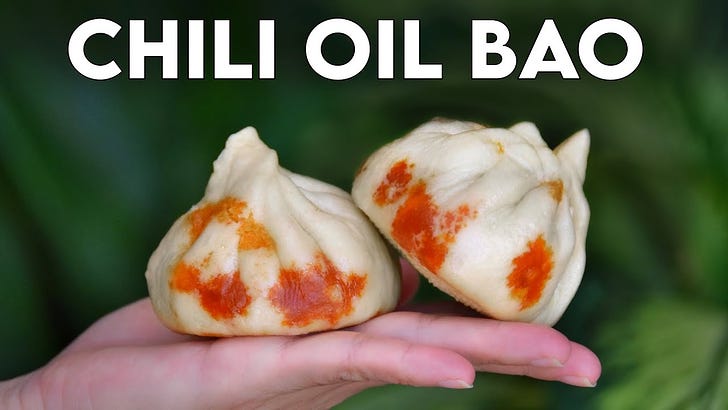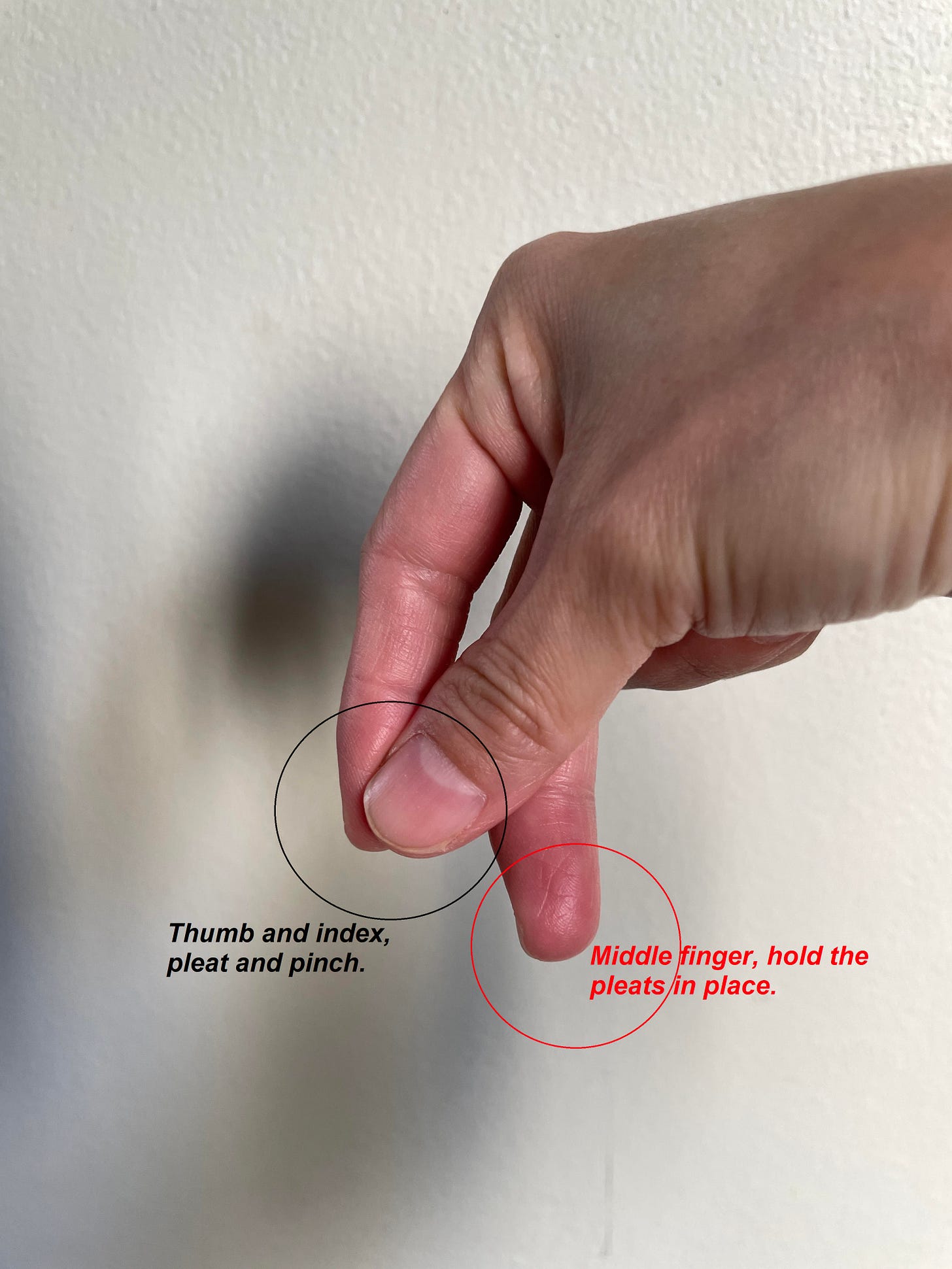Baozi are - sort of like sandwiches - one of those dishes that’s more of a ‘category’ than a dish per se. Of course, there’s the famous ones - the hoagie, the pork bao; the cheesesteak, the Char Siu Bao - stuff that everyone knows. But for every grilled cheese… there’s a Pittsburgher Fried Fish, a Falls Riveran Chow Mein Sandwich or a Buffalonian Beef on Weck. And while the greats are great for a reason… sometimes it’s those dusty, hyper-local, deeply idiosyncratic corners that’re the most interesting to explore.
And the world of Chinese Baos? Equally eclectic.
You might know the Dim Sum classics - stuff like Custard Buns or the aforementioned Char Siu Bao. But how about… lamb with welsh onion? Beef with shiitake? Shrimp with pork? Daikon with dry krill? Fermented mustard green with glass noodles? Even if we zoom in on just the fillings (there’s a whole separate world of wrapper variants), there’s a mind-boggling array of regional variants. Pretty much anywhere you go… you can find people taking their favorite foods, and stuffing it inside of a Baozi.
So then, in Sichuan? It’s probably no surprise that you can find - in pockets - a Chili Oil Baozi (红油包子).
Now, Chili oil baozi could be loosely conceptualized as pretty much any type of baozi that contains a… non-insignificant amount of chili oil. Sometimes you see a quick chili oil made from rendered pork fat, like the sort we’ll be making today. But you also find much more complex variants that use the more elaborate Sichuan Red Chili Oil (红油) as the base of the seasoning. Some go heavier on Sichuan chili bean paste, others more on chili powders. The filling can be meat, or vegetarian… and you can also sometimes find Yibin yacai (Sichuan fermented mustard green), scallion, or bamboo shoot in the mix as well.
So below, we’ll be showing you the basic concept of how to achieve a Sichuan style chili oil baozi. But definitely make this your own - pork into beef, turn it vegetarian, whatever.
Chili Oil Baozi
As you can tell from the above thumbnail, Chili Oil Baozi tend to have this classic look - the chili oil inside forms these sort of red ‘pockmarks’ on the bun, practically begging you to burst the thing open and devour the spicy interior.
This is the type of thing that’s almost mandatory to achieve if you’re a hawking on the street or making a YouTube thumbnail, but isn’t necessarily that required if you’re cooking for yourself at home. So while we did pull all the stops to achieve that… if you’ve already got a Baozi wrapper recipe you enjoy, feel free to use that instead.
Either way, that look? It’s achieved via… very long proofing times.
And you get those long proofing times using… Chinese sourdough.
But because we feel bad giving you a recipe that requires a multi-day project beforehand, we’ll be giving you two versions here: (1) the sourdough sort and (2) one using yeast.
Ingredients:
Note: in the accompanying video, the stated pork filling quantity is double what’s listed below. This is because we were making enough filling for two batches - both the sourdough kind and the yeast kind. Assuming you’re making one batch, use the quantities below - not what’s listed in the video! (unless you want extra)
For the chili oil:
Lard (猪油), or Caiziyou (菜籽油, good quality rapeseed oil, not canola), or a fragrant peanut, 20g
Ginger (姜), sliced 5g
Scallion white (葱白), 5g
Sichuan chili bean paste (郫县豆瓣酱), 1/2 tsp or 2g
Red fragrant chili powder (辣椒面), e.g. gochugaru, Kashmiri, 1 tsp or 2g
Sichuan peppercorn powder (花椒面), 1/8 tsp
Five spice powder (五香粉), 1/8 tsp
For the pork filling:
Pork shoulder (梅花肉/猪肩肉), ground, 70g
Sichuan chili bean paste (郫县豆瓣酱), 1/2 tsp or 2g
Ginger (姜), ~1cm, 4g, minced.
Scallion white (葱白), from ~1 sprig, 5g, minced
Soy sauce (生抽), 1 tsp or 5g
Liaojiu aka Shaoxing wine (料酒/花雕), 1 tsp or 5g
Sugar, 1/4 tsp
MSG (味精), 1/8 tsp
Chili oil, from above
Water, 1 tsp or 5g
Scallion green (葱花), from ~1 sprig, or 7g, sliced
For the Chinese Sourdough (Laomian) version [Baker’s Percentages in Brackets]:
Chinese Laomian sourdough (老面), 20g [20%]
AP flour (中筋面粉), 100g, plus 10-15g extra for dusting
Water, 50g total, added in two steps as 45g+5g [50%]
Sugar, 8g [8%]
Salt, 1g [1%]
Baking soda (小苏打), 1g, [0.6% to the weight of the fermented dough]
For the yeast version [Baker’s Percentages in Brackets]:
AP flour (中筋面粉), 100g
Water, 50g-57g depending on the absorption of your flour [50-57%]
Yeast, 2g [2%] if using instant dry yeast; 1g [1%] if using an osmotolerant yeast (耐高糖酵母) like SAF Instant Blue.
Sugar, 8g [8%]
Salt, 1g [%]
Process:
For the chili oil:
To a hot wok, swirl in the 20 grams of lard (or your oil of choice). With the heat on low, fry the ginger slices and scallion white until slightly golden brown. Remove, and shut off the heat.
Add in the 1/2 tsp Sichuan chili bean paste, turn the heat back on low, and fry it for about 2 minutes until it slightly dries up. Then add the red fragrant chili powder, Sichuan peppercorn powder and five spice powder, quickly fry them until the oil starts to bubble, then shut off the heat. Set aside to cool down.
For the pork filling:
On a chopping board, add the scallion whites, the ginger, and the 1/2 tsp of Sichuan chili bean paste to your minced pork. With a knife, mince and fold the ingredients until combined, ~1 minute, then add the sediment from the chili oil to the mix as well. Continue to mince and fold until turns pasty and even, ~3 minutes. Transfer to a bowl.
Now add in the soy sauce, the liaojiu aka Shaoxing wine, the sugar, and the MSG. Mix well, ~1 minute, then mix in all the chili oil and the water. Taste for salinity.
To taste a Baozi or Dumpling filling: take about a ~1tsp of filling and spread on a tiny plate. Microwave on medium for 30 seconds. Tasting, it should feel slightly saltier than what you’re used to a stir fry dish, as it’ll also need to season the surrounding Bao wrapper.
Add more salt if needed, then fold in the scallion greens. Pop in the fridge to firm up as you’re working on your dough.
For the Chinese Laomian Sourdough Wrappers:
Dissolve the Chinese sourdough with 45g water, then add in AP flour, and stir into rough shaggy bits. Press it into a rough ball, cover, then set it aside until it doubles in size. A transparent container would be ideal to observe the progress. [Reference fermenting time: 4 hours at a room temp of 28C.]
Remove the dough, and fold the salt and sugar in. In a separate small bowl, dissolve the baking soda in 5g water. Smear some baking soda solution onto the dough and start kneading, adding the baking soda solution periodically. Keep on kneading until the dough is smooth and white, ~ minutes. You can sprinkle some flour on if it gets sticky (both the laomian sourdough and the relatively high sugar content of this dough can contribute to a softer and stickier dough).
Then, portion the dough into six even pieces, about ~30g each. To do so in the traditional Chinese way… first shape the dough into a ball, poke a hole at the center, and shape it as a doughnut. Tear into a log, and then tear that into your six pieces.
Dust your work surface. Grab one piece, and press into a disc with center of your palm. Then roll by grabbing one end of the rolling pin, roll it from inside out, using a bit more force on the edge to roll it thinner on the outer ring. Keep the end of the rolling pin within the disc to create a relatively round shape. Roll them all into 10cmish-wrapper.
Take the filling out from the fridge, quickly stir to keep the oil incorporated. Take ~20g of filling, place it on the wrapper, then use thumb and index finger to pinch it close while using the middle finger of the same hand to hold the pleats in place.
Twist the bao on the palm as you pleat, press the filling in with your thumb of the non-pleating hand if needed, and pinch it closed at the end. Place in the steamer on top of a steaming mat or cut out parchment paper [6*6 cm or 2.3*2.3 inch]. The Bao should be at least 1 inch apart from each other.
Proof over 30C water for one to 1.5 hours, or when it passes the poke test - i.e. you poke the bao, the dough slowly bounces back in 2-3 seconds.
Steam on high for 10 minutes over boiling water, then heat off and rest two before taking them out.
Best served hot.
For the Yeast Dough:
To the AP flower, add the yeast in on one side of the bowl and the salt and sugar on the other. (Note: separating yeast and salt/sugar is a personal preference of ours… if you don’t think your yeast would be affected, then you can mix them together)
Slowly drizzle in the water to form small, shaggy bits. If you’re using non-Chinese flour (e.g. King Arthur’s, which tends to need more water), drizzle in a bit more if there’s still quite some dry flour in the bowl. Past experience with the help from our extraordinarily talaented Patron ‘Baobarian’ points to a hydration of 55-57% for that brand.
Press the dough together, transfer to a work surface and start kneading by pressing out and folding back. Once the dough is white and smooth, shape into a ball and cover to ferment until doubles in size - roughly 1-1.5 hours, depending on your ambient temperature.
Then, portion the dough into five even pieces, about ~30g each. To do so in the traditional Chinese way… first shape the dough into a ball, poke a hole at the center, and shape it as a doughnut. Tear into a log, and then tear that into your five pieces.
Dust your work surface. Grab one piece, and press into a disc with center of your palm. Then roll by grabbing one end of the rolling pin, roll it from inside out, using a bit more force on the edge to roll it thinner on the outer ring. Keep the end of the rolling pin within the disc to create a relatively round shape. Roll them all into 10cmish-wrapper.
Take the filling out from the fridge, quickly stir to keep the oil incorporated. Take ~20g of filling, place it on the wrapper, then use thumb and index finger to pinch it close while using the middle finger of the same hand to hold the pleats in place.
Twist the bao on the palm as you pleat, press the filling in with your thumb of the non-pleating hand if needed, and pinch it closed at the end. Place in the steamer on top of a steaming mat or cut out parchment paper [6*6 cm or 2.3*2.3 inch]. The Bao should be at least 1 inch apart from each other.
Proof over 30C water for 30 minutes, or when it passes the poke test - i.e. you poke the bao, the dough slowly bounces back in 2-3 seconds.
Steam on high for 10 minutes over boiling water, then heat off and rest two before taking them out.
Best served hot.






Can these be made ahead and frozen? If so, when would you recommend freezing in the process? Wasn't sure if I should do the final 30min proof and then stop or potentially fully cook them before freezing